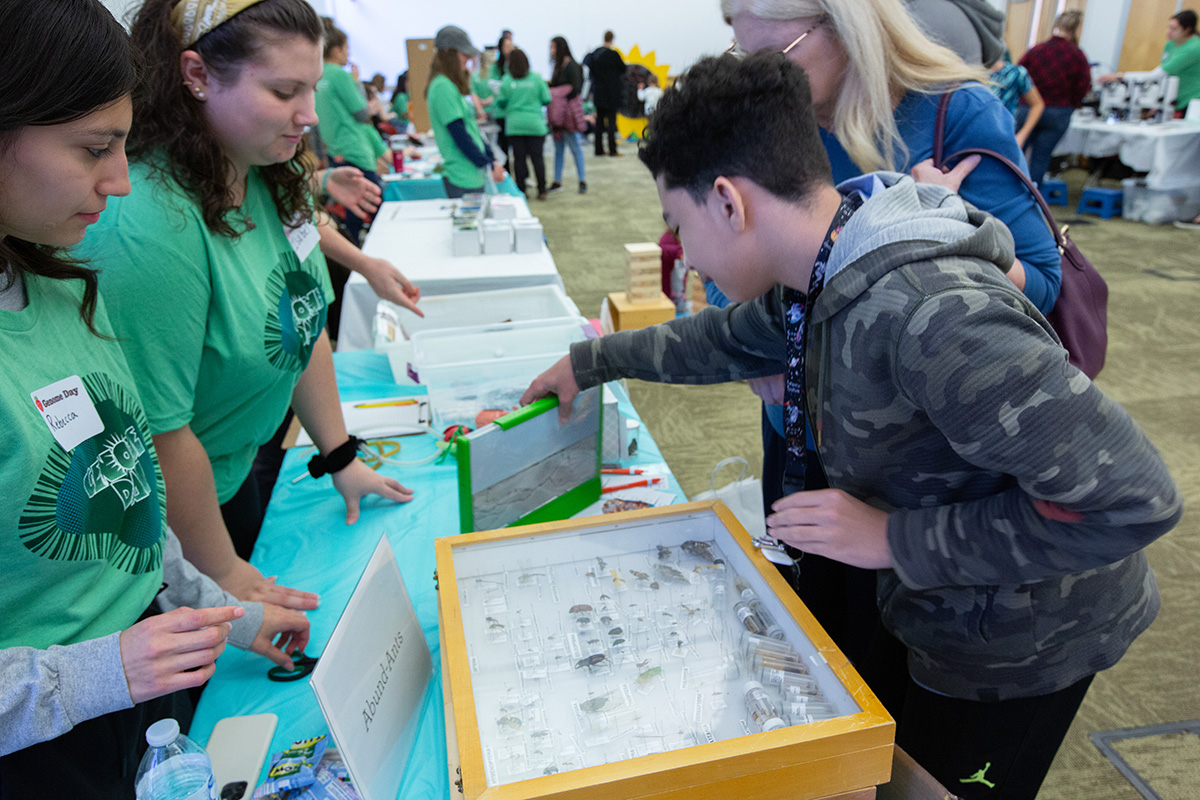Genome Day brings the wonders of genetics and nature to life

Genome Day, 2023 at the Lincoln Square Mall / Julia Pollack
From microorganisms and DNA extraction to poison frogs and lemon-scented ants, the Carl R. Woese Institute for Genomic Biology’s Genome Day brought science to life across a wide variety of scales. Families, students, science lovers, and local community members explored stations and activities led by IGB faculty, staff, and students.
The annual outreach event took place over two weekends, first at the Lincoln Square Mall in Urbana and then at the Champaign Public Library. The mission of Genome Day is to communicate research across all fields of biology to the public in an accessible way and motivate people to get more involved in science.
Among the most popular stations for the younger attendees were Build-A-Bird and Delicious DNA. At Build-A-Bird, attendees build bird models and learned how different adaptations can help organisms in different environments. They would first spin a wheel to find out what type of traits their bird would have, including various options for beaks, tails, and wings. Then, they would learn about what environments their bird would be most successful in. As one participant in elementary school described, “I learned that tail length affects flight duration, and short-tailed birds fly faster and are more agile.”
At Delicious DNA, volunteers helped everyone extract DNA from strawberries. Using basic household products, DNA can be isolated from strawberries. Attendees then had the option to make necklaces with their DNA samples attached. One participant shared, “It was cool to see how something that I normally think of as really small actually takes up a lot of space in an organism.”
Another exciting part of Genome Day was the inclusion of multiple stations with live animals, allowing the public to observe the behavior and adaptations of different species. The Fun with Frogs station featured both poison frogs and glass frogs, and an interactive map showing off all of the locations where these fascinating organisms can be found. “I learned that poison frogs aren't born poisonous, it’s the food they eat that makes them poisonous,” shared one attendee.
Another station, called Abund-Ants, showed off live ant colonies from three ant species native to Illinois—citronella ants, odorous ants and funnel ants. Everyone was captivated by the complex tunnels built by the citronella ants, a small yellow ant that gets its name from the lemon scent they produce when they are threatened. Rebecca Carranza, a volunteer at the station and a current PhD student of ecology and evolutionary biology, shared her experience at Genome Day. “It was really fun! My favorite part was interacting with other community members who shared my love of insects. Seeing them get excited about cool ant facts was really rewarding.”

In addition to genetics and nature, a number of the activities at Genome Day focused on the human body and why genomics matters for our own biology. This included the Skeleton Scramble station, where attendees could compare the bone structure of different organisms and learn about how the bones fit together to support the body. The Viruses & Vaccines and Amazing Antibodies stations helped attendees understand the science behind getting sick. One attendee explained, “It was fascinating to learn that antibodies work faster the second time, because they have seen that virus before.”
Throughout the sights and sounds of Genome Day — attendees asking volunteers questions, kids carrying around various science-inspired crafts, people adjusting microscope lenses, giant Jenga blocks representing animals in a food web toppling over — one thing became clear: regardless of background or expertise level, science brings together communities around a common goal to further knowledge, understand the world around us, and appreciate the incredible discoveries that are made every day. Organizers, volunteers, and attendees alike are already anticipating what will be in store for next year.
